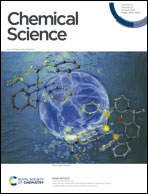Electrostatic vs. inductive effects in phosphine ligand donor properties and reactivity†
Abstract
Enhanced rates and selectivity in enzymes are enabled in part by precisely tuned electric fields within active sites. Analogously, the use of charged groups to leverage electrostatics in molecular systems is a promising strategy to tune reactivity. However, separation of the through space and through bond effects of charged functional groups is a long standing challenge that limits the rational application of electric fields in molecular systems. To address this challenge we developed a method using the phosphorus selenium coupling value (JP–Se) of anionic phosphine selenides to quantify the electrostatic contribution of the borate moiety to donor strength. In this analysis we report the synthesis of a novel anionic phosphine, PPh2CH2BF3K, the corresponding tetraphenyl phosphonium and tetraethyl ammonium selenides [PPh4][SePPh2CH2BF3] and [TEA][SePPh2CH2BF3], and the Rh carbonyl complex [PPh4][Rh(acac)(CO)(PPh2(CH2BF3))]. Solvent-dependent changes in JP–Se were fit using Coulomb's law and support up to an 80% electrostatic contribution to the increase in donor strength of [PPh4][SePPh2CH2BF3] relative to SePPh2Et, while controls with [TEA][SePPh2CH2BF3] exclude convoluting ion pairing effects. Calculations using explicit solvation or point charges effectively replicate the experimental data. This JP–Se method was extended to [PPh4][SePPh2(2-BF3Ph)] and likewise estimates up to a 70% electrostatic contribution to the increase in donor strength relative to SePPh3. The use of PPh2CH2BF3K also accelerates C–F oxidative addition reactivity with Ni(COD)2 by an order of magnitude in comparison to the comparatively donating neutral phosphines PEt3 and PCy3. This enhanced reactivity prompted the investigation of catalytic fluoroarene C–F borylation, with improved yields observed for less fluorinated arenes. These results demonstrate that covalently bound charged functionalities can exert a significant electrostatic influence under common solution phase reaction conditions and experimentally validate theoretical predictions regarding electrostatic effects in reactivity.



 Please wait while we load your content...
Please wait while we load your content...